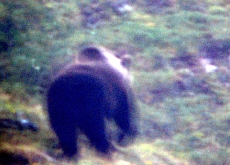Swiss authorities prepare ground for bears

A solitary brown bear returned to Swiss territory last July, gaining immediate celebrity status because it was the first to be seen in the country since 1904.
In response, the authorities have put together a strategy document – known as the Bear Concept – to manage and protect the species.
The Federal Environment Office’s document, which gives guidelines on the balance between the interests of bears and humans, has been sent to the relevant organisations for consultation.
“It is necessary to create an agreed policy for certain rare species like the lynx, wolf and bear because these are species which can cause damage and conflict,” Reinhard Schnidrig of the Environment Office told swissinfo.
“Because you have a big problem, you try with all the people involved – the cantons, hunting groups, farming associations and nature conservation organisations – to find the middle ground,” Schnidrig added.
The concept defines what steps to take when a bear is discovered on Swiss territory, especially in the case of bears that have lost their natural shyness of humans and become potentially dangerous.
The first response would be to frighten the bear, while killing is reserved as a last resort.
Roland Schuler of the conservation organisation Pro Natura said the priority was to ensure that the bear coexists peacefully with people.
“Public awareness is very important and it is covered by the concept. A bear is a predator and we have to relearn the forgotten skill of how to deal with the animal,” Schuler said.
Shooting policy
Under federal law, it is possible to shoot an animal if it causes damage, but the concept goes into more detail on what kind and extent of damage requires intervention in the case of bears.
With wolves and lynxes, local authorities have the right to shoot animals who cause excessive damage to livestock. This will not be allowed with bears, and prevention measures are recommended instead.
Any interested parties can now react to the document and make submissions to the Environment Office by April 15. The concept will then be reworked to reflect these opinions and is expected to come into force in June.
Last year’s bear, known as JJ2, came from an established population founded by the Italians in the Trentino region, about 70 km from the Swiss border.
The bear caused some controversy, killing one calf and more than 20 sheep in his first weeks in the area.
It is currently hibernating in an unknown location. “When he wakes up again, we will try to capture him to put on a radio collar and then whenever he gets too close to humans we will try to teach him by scaring him away,” Schnidrig explained.
“What’s different with this species is that a bear can be a danger to people. The big challenge of this concept is to keep the natural distance between man and bear, for the good of both.”
Curious
Paolo Molinari of Kora, which coordinates research projects for the conservation and management of carnivores in Switzerland, explained that JJ2 may be exhibiting some problem behaviour.
“The bear has learned from his mother to associate humans with food. He is pretty curious but that doesn’t mean he is aggressive. We will try through special management measures to minimise any potentially dangerous situations.”
According to Molinari, if JJ2 is in the southeastern Swiss canton of Graubünden he will not wake for a couple of months. If he is in the Italian Trentino region he will wake up sooner but is not likely to return to Switzerland until the summertime.
“Graubünden is a very good habitat for bears in the summer,” he said.
Schnidrig anticipates that more young bears will make their way to Switzerland over time. “We’ll never get a big population, maybe we’ll have five or ten or 15.”
“The bear is part of our fauna and it belongs in the Alps. It is a challenge for us in Switzerland and all the alpine countries to get together to create space for the bear in the Alps,” Schnidrig said.
There are an estimated 50,000 brown bears in Europe in separate fragmented populations.
Brown bears are omnivores and feed on plants, berries, roots, fungi, fish, insects and small mammals.
They like to den in a protected spot during the winter months.
Brown bears can grow to a huge size, males up to 350kg, females to 200kg.
Bears, along with wolves and lynxes, were hunted to extinction in the Alps in the 19th century. The last bear in Switzerland was killed in 1904.
A single male brown bear appeared in Müstair valley in southeastern Switzerland last July, crossing over from the Italian side of the border.
The bear, which caused a sensation in the national press, is now in hibernation in an unknown location in the region.
In anticipation of more bears straying into the country, the Federal Environment Office is preparing a strategy document, setting out guidelines for the management of bears on Swiss territory.

In compliance with the JTI standards
More: SWI swissinfo.ch certified by the Journalism Trust Initiative












You can find an overview of ongoing debates with our journalists here . Please join us!
If you want to start a conversation about a topic raised in this article or want to report factual errors, email us at english@swissinfo.ch.